内连接和外连接
Posted cjaaron
tags:
篇首语:本文由小常识网(cha138.com)小编为大家整理,主要介绍了内连接和外连接相关的知识,希望对你有一定的参考价值。
简介
等值连接 非等值连接 特殊的自连接都属于内连接
- 内连接:符合连接的条件的数据被选中,不符合条件的数据被滤去
- 外连接:外连接的结果集等于内连接的结果集加上匹配不上的记录(一个也不能少)
如何实现外连接
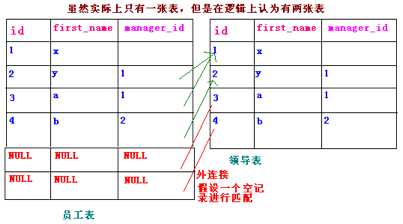
(+) 把(+)字段对面的表的数据全部被匹配出来
select distinactt m.id,m.first_name from s_emp e,s_emp m where e.manager_id(+)=m.id;
(+)把领导表里的普通员工用NULL匹配(这是连接条件)
找普通员工也要从领导表中找,因为领导表中有绝对条件证明谁是领导,但是员工表里没有这个绝对条件。所以要把领导表中的数据全部匹配出来,所以(+)要加到员工表的字段上,这样领导表里的所有数据就都被匹配了(普通员工匹配的是NULL),要找普通员工时,只要找员工表里匹配的manager_id是NULL的就能找到普通员工(这是过滤条件)
select distinct m.id, m.first_name from s_emp e, s_emp m where e.manager_id(+)=m.id and e.manager_id is null;
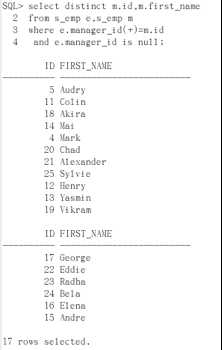
演示一:
select * from s_dept; select * from s_region;
(1)内连接:要求显示每个部门的id 和部门对应的名字 以及对应的地区名
select d.id, d.name, r.name from s_dept d, s_region r where d.region_id=r.id;

显示了12条数据。
(2)业务扩展,成立新部门 id为100,name为test region_id为NULL
insert into s_dept values(100 ,‘test’,NULL);(表中的增加)

再用上面的方法查找就只找得到原来的,新增加的找不到,因为region_id为NULL。
(3)所以用外连接使没有地区编号的部门也要显示出来,因为要把部门表里的所有部门匹配显示出来,那么就要把(+)加在地区表上
select d.id, d.name, r.name from s_dept d, s_region r where d.region_id=r.id(+)
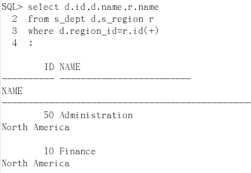
。。。。。。

演示二:
(1)内连接:统计每个员工的id salary,并显示工资的工资级别(用到s_emp和salgrade表)
select e.id, e.salary, s.grade from s_emp e, salgrade s where e.salary between s.losal and s.hisal;
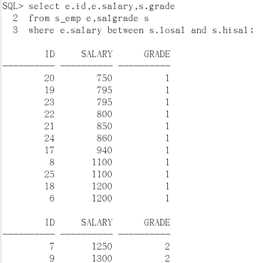
。。。。。。

(2)有一天把老板的工资改为12500,超出了salgrade的统计范围。
update s_emp set salary=12500;

再用上面的方法找,老板的就丢失了!
select e.id, e.salary, s.grade from s_emp e, salgrade s where e.salary between s.losal and s.hisal order by id;
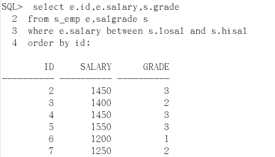
。。。。。。

从结果可以看出,没有了“id=1”的老板的项目。
(3)所以要用外连接把超出统计范围的员工信息也要显示出来。因为要把员工信息表的所有信息匹配显示出来,所以要在salgrade对应的的字段上加(+),这里要加两个。
select e.id, e.salary, s.grade from s_emp e, salgrade s where e.salary between s.losal(+) and s.hisal(+) order by id;
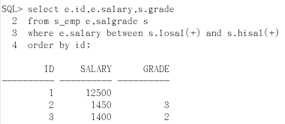
总结
每次写外连接时,可以先写号内连接(写好内连接要搞清楚表和表之间关系以及业务逻辑),再加上(+),就是用NULL匹配。因为外连接的结果集等于内连接的结果集加上匹配不上的记录。
(+)字段对面的表的数据全部被匹配出来
(+)只针对oracle数据库
但是所有数据库的语法机制是差不多的,只是表现形式有变化
- 表连接:
- 内连接:
- 等值
- 非等值
- 自连接
- 外连接:
- 等值
- 非等值
- 自连接
- 内连接:
额外补充
sql99中规定的内外连接
- 内连接:
from a表,b表 where 连接条件变为99标准: from a表 join b表 on 连接条件(过滤条件不能写在一起) 或者from a表 inner join b表 on 连接条件
演示:列出每个部门的名字和对应的地区名
通常使用的:
select d.name, r.name from s_dept d, s_resgion r where d.region_id=r.id;
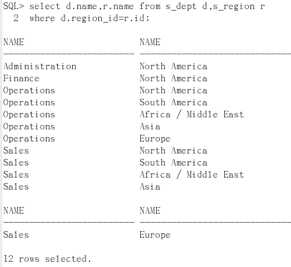
99标准的:(一般不怎么用)
select d.name, r.name from s_dept d, join s_region r on d.region_id=r.id;
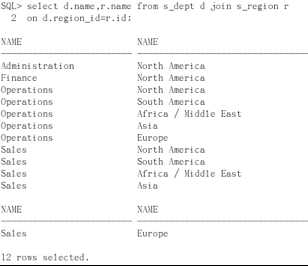
- 外连接
- 左外连接:a表发起连接,a表的数据全部被匹配出来(通过NULL记录来全部匹配)
from a表 left outer join b表 on 连接条件;
oracle使用的(+):
select d.name, r.name from s_dept d, s_region r where d.region_id=r.id(+);

99标准的:
select d.name, r.name from s_dept d left outer join s_region r on d.region_id=r.id;
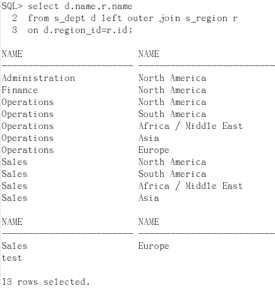
-
- 右外连接:b表发起连接,b表的数据全部被匹配出来
from a表 right outer join b表 on 连接条件;
-
- 全外连接:实际上只是一个逻辑概念,实际用途中没什么用。全外连接的结果集等于左外连接的结果集加上右外连接的结果集,并且排除重复部分(就是左右两张表都全部匹配,a表b表书写顺序随便)
oracle无法使用(+)实现全外连接
from a表 full outer join b表 on 连接条件;
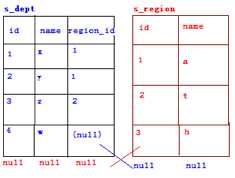
oracle的全外连接
引用两个关键字union和union all
- union:可以合并两个结果集,然后排重
- union all:可以合并两个结果集(不排重)
比如:
select id from s_emp unoin ; 输出25条数据 select id from s_emp unoin all ; 输出50条数据
以上是关于内连接和外连接的主要内容,如果未能解决你的问题,请参考以下文章